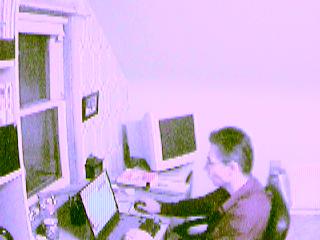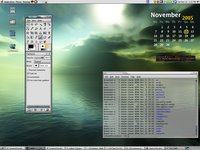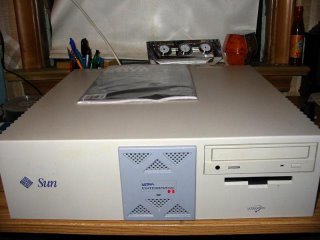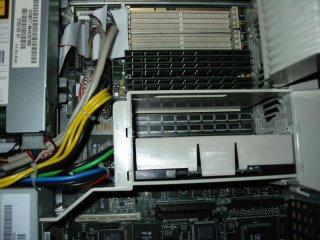Thursday, February 02, 2006
If you've never ventured outside of x86 land...
The other thing that's cool is 64-bit. Yes, my 200MHz Ultra 2 is a 64-bit box. It can hold 1GB of RAM, and it's dual processor capable. Not bad for a $20CDN ebay purchase. (I spent more buying the keyboard and mouse for it).
If you've never ventured out of x86 land, I strongly recommend you try it... just for the pleasure of trying something outside the norm.
Tuesday, January 31, 2006
AOpen AX6BC motherboard and Linux
As it turns out, the problem was indeed the BIOS. AOpen motherboards with the model AOpen AX6BC version R2.10, dated 1998, seem to have an issue with operating systems other than Microsoft Windows. I checked the AOpen web site, but there was no mention of Linux issues. I found a newer BIOS for the AX6BC, version R2.59. As per AOpen's instructions I booted to a command prompt, and ran the BIOS update from floppy.
The BIOS update seemed to go perfect. When I rebooted there was a CMOS checksum error. At first I thought I'd go into the BIOS and see if there was somewhere to change the checksum. I skimmed the BIOS very quickly - no go. As it turns out, all I had to do was press F1 to Continue. The next reboot the CMOS error was gone.
Friday, January 27, 2006
More on the Ultra 2
At the moment a broken version of Debian Woody is installed on the hard drives. (4% and 1% use on the 9.1GB drives - pretty slim!) I downloaded Gentoo, and while I found it a pain to install on my notebook, which is really my lifeblood of computer systems, I have the time to play with it on the Ultra, and I like the idea of rolling my own custom kernels on this unusual box. My only concern is what will happen when I add a second processor; I'm guessing it'll just be a simple matter of a recompile - no big deal.
I have to say that I am really impressed with what Gentoo looks like on the console of this box. I don't think I've seen prettier console colours since my days of running a Bulletin Board System. Another cool aspect of the Gentoo minimal live CD is that it seems to have detected the onboard sound AND the Sun Turbo GX card, which I had looked up in preparation for a more difficult install. And while Gentoo will probably be a lot more reading than a Debian install, I expect the result will be a much nicer system, better tuned to my resources.
I've decided to use the Ultra 2 to serve up a simple web site, and to learn Python on. At some point I want to start developing games using the pygame library. The pygame web site shows a lot of pretty cool looking games - look out Roberta Williams! This latest bout of programming euphoria brought about by the book Masters of Doom which documents id's rise to the top of the shareware, and retail gaming world.
Well, it's 5am, so I'm not adding any links - I really need sleep, big day ahead at 7:30!
Thursday, January 26, 2006
Updates and Sun Ultra Enterprise 2 active
And a quick note that I finally got a hard drive for my Sun Ultra 2 Enterprise, a 9.1GB SCSI drive. I put Solaris 9 on it last night - a very long install. More later this evening.
Thursday, December 08, 2005
A SOHOWare experience
I finally broke down and burned a copy of the multi-megabyte driver from SOHOWare, and after a couple more false starts, and needing to know what path things were stored at, we managed to get the driver working. In short, it took A LOT of effort!
Now I know I'm comparing apples and oranges when comparing Windows 95 and Linux, but only slightly. The machine in question wasn't capable of running Windows XP, at least not well. Had I put Debian GNU/Linux on the machine it would have picked up the SOHOWare card right away with a newer kernel. People always talk about how *easy* things are in Windows, forgetting minor irritants like the experience I just mentioned above. My point of all this is that Linux does have better hardware support than Windows. If you consider how badly XP would run on such a machine (64MB RAM), and the fact that installing the 95 driver is a royal PITA unless you waste a CD-R, installing a Linux distribution like Puppy Linux or Debian GNU/Linux seems like a breeze.
Resources
Friday, November 25, 2005
Vanquishing technology
 If you've been following my web log, you know I have an almost fanatical interest for unusual hardware. It seems that fanaticism extends to non-computer hardware too. And while I might be able to buy a (once) $60,000 computer on eBay for $20CDN, the piece of hardware I got turned on to this evening would never sell for anything remotely as cheap as the Sun Ultra 2.
If you've been following my web log, you know I have an almost fanatical interest for unusual hardware. It seems that fanaticism extends to non-computer hardware too. And while I might be able to buy a (once) $60,000 computer on eBay for $20CDN, the piece of hardware I got turned on to this evening would never sell for anything remotely as cheap as the Sun Ultra 2.I was watching the modern version of The Italian Job, and decided to look up "Handsome Rob's" thrill machine, the Aston Martin Vanquish. Baby, the Vanquish is one dream machine! It's capable of burning up the road at over 200mph, does 0-60 in less than 5 seconds, even comes digitally, and electronically customizable with the owner's name plate - we're talking dream machine!
I've watched this version of The Italian Job a few times, and so much attention is focused on the Mini Coopers that the rest of the cars barely have any chance for limelight. Aston Martin's web site is pretty slick, but I was somewhat annoyed when I visited the web site of the Toronto dealer for AM; when I brought up the page for the Vanquish the site played the theme from James Bond. If you're trying to project class, playing the theme song from James Bond is not the way to do it.
The V12 in the Vanquish reminded me of this site I came across this morning, a V12 made almost entirely out of paper! Cool hack!
Resources:
- Aston Marton (requires Flash)
- Techeblog paper V12 article
Wednesday, November 16, 2005
Camstreams and lftp

In my last post I alluded to a web-cam project I was working on. I had hoped the software I was using for Linux, Camstream, was capable of uploading to me site, and there appeared to be facilities to do so - the only problem was that all the images it uploaded had a zero-byte size; in other words the upload didn't work properly. Luckily, Camstream did save the image perfectly to the hard drive, which meant I could use a little scripting to auto upload it to my web site.
I'm no hard core shell script hacker, this is just my solution to a problem; I'm sure there are plenty of better solutions, but this one works for me, so I thought I would share:
First I needed to find a ftp program that I could script. I chose lftp because it seemed like the easiest program to script, you just run lftp with the -f switch and the name of your script. For example, if your script is called uploadimage you'd get cron to run:
/usr/bin/lftp -f /home/username/uploadimage
Where /home/username is the path to where you put your script. The second job was to write a script that would upload the image. This was actually just a few lines of script:
open -u myusername,mypassword my.ftp.server.address
rm /img/videocamera.jpg
put -c -O /img /home/myusername/videocamera.jpg
quit
It's a very simple script. The first line connects to the ftp server at my.ftp.server.address. Line 2 removes the existing image. Line 3 puts the new image with a switch to overwrite the old image if it exists. And the last line ensures lftp quits.
I tested the script before putting it in a cron job by typing:
lftp -f /home/myusername/uploadimage
When it worked I put the script into a cron job:
0,5,10,15,20,25,30,35,40,45,50,55 * * * * /usr/bin/lftp -f /home/myusername/uploadimage
The 0,5,10,15... part ensures the cron job runs every 5 minutes. The other four stars ensures the job runs every day of the week. Now, I probably should have mentioned how to edit a cron job in the last post, and before I posted the line above, but it's been a long day and I'm still trying to wind down, so here it is: as root type:
crontab -u myusername -e
Substitute the user name you use on your local Linux system, not the username you would use on your ftp site.
The last element was creating a simple html page to display the image videocamera.jpg. I won't explain the mechanics of HTML here, but I'll mention that I borrowed some javascript code, and hacked it to refresh the web page itself about every 3 minutes.
Resources:
Please note that if the camera feed is black it's probably dark out, or I'm chilling watching a movie. I still have a way to go with this project and will probably run the images through imagemagick, but that's another post...
My first "real" computer was an IBM PC/XT. While our family had a Commodore 64, I don't think anyone would argue that it was anything but a game machine, at least not the way we used it. Since the XT was my introduction to the Personal Computer market, I got pretty use to IBM and Microsoft DOS (Disk Operating System).
I've never been much of a code hacker/junkie, but I did slap together quite a few batch files to get DOS to save me a few steps. Under Linux you can also script things. Most scripts begin by pointing to whatever shell you're using. I would imagine that a good 60% of the Linux community is using good old Bash. An example bash script:
#!/bin/bash
echo "Shell scripting is fun"
Then you would change permissions on the script to include execute permission, at least for yourself. Be wary of arbitrarily running shell scripts which you don't know the purpose of - you don't want to run a rootkit.
chmod ug+x myshellscript
Now the user who created myshellscript has permission to run it, as does anyone who belongs to the same group as the user.
So what good is all this? When combined with another tool, cron, you can schedule your script to run at certain intervals. I've set up a cron job that runs a script which connects to a ftp server and uploads a web cam image at certain intervals.
I won't go into the details of cron because this post is long enough, but the links below should help.
Resources:
Cheers until next time!
Monday, November 14, 2005
UltraSparc T1

Sun Microsystems has unveiled a new processor in its UltraSparc line of processors, the UltraSparc T1, codename Niagara. The chip boasts 8 "computing engines" and according to an article on ABC News, uses about half the power of traditional processors.
I hope this improves sales of Sun machines. I'd like to see Sun stick around. Sun has made some pretty sweet machines, and it's nice to have an alternative to the Intel/AMD architecture, even if the machines are a little expensive.
Go Sun, go!
Resources:
Sunday, November 13, 2005
Ultra 2 almost $60k!
The Ultra 2 Creator 3D 2200 comes with a pair of 200-MHz UltraSPARC CPUs, 256 megabytes of RAM, a 4 gigabyte hard disk, and 20-inch monitor. It costs $59,995. With a multi-threading, multi-processing SunSoft compilers, the Ultra 2 generates 332 SPECint92 and 505 SPECfp92, the highest recorded floating-point SPEC92 results.
It sounds like I may have got even more of a bargain than I thought!
Resources:
Saturday, November 12, 2005
Screenshot of Fedora Core 4 with extras
 One of the things I love most about Linux is how customizable it is! While the same is somewhat true of Microsoft Windows, you usually have to buy add-ons like Stardock Window Blinds. The see through calendar is gdeskcal, the music player just below is a minimized version of xmms, and I have The Gimp opened.
One of the things I love most about Linux is how customizable it is! While the same is somewhat true of Microsoft Windows, you usually have to buy add-ons like Stardock Window Blinds. The see through calendar is gdeskcal, the music player just below is a minimized version of xmms, and I have The Gimp opened.Resources:
More pictures soon.
Thursday, November 10, 2005
Sun Ultra Enterprise 2 photos
 The Sun Ultra Enterprise 2 I ordered on eBay arrived yesterday, 2 days after it was shipped - amazing! Unfortunately the box seems to hang at the beginning of the memory count. I suspect the problem is the RAM configuration. I read somewhere that the minimum RAM configuration would be 128MB of RAM because the RAM is installed 4 DIMMs at a time, with 32MB RAM the minumum (4x32MB=128MB). My machine has 8 sticks of RAM, but shows 64MB at the top. I won't speculate beyond this, but I may have some other RAM coming.
The Sun Ultra Enterprise 2 I ordered on eBay arrived yesterday, 2 days after it was shipped - amazing! Unfortunately the box seems to hang at the beginning of the memory count. I suspect the problem is the RAM configuration. I read somewhere that the minimum RAM configuration would be 128MB of RAM because the RAM is installed 4 DIMMs at a time, with 32MB RAM the minumum (4x32MB=128MB). My machine has 8 sticks of RAM, but shows 64MB at the top. I won't speculate beyond this, but I may have some other RAM coming. My machine has a single 200MHz UltraSparc processor. It's possible that it might take up to a 400MHz processor, but even if it doesn't, the machine is still dual processor capable. I was amazed at the internals of this machine, everything is packed pretty tighly. I couldn't even see a spot I might stick a hard drive other than under the floppy bay. The Ultra 2 is a heavy beast! I'm somewhat surprised I only paid $14US for shipping, considering how fast the machine arrived, its packing, and weight.
My machine has a single 200MHz UltraSparc processor. It's possible that it might take up to a 400MHz processor, but even if it doesn't, the machine is still dual processor capable. I was amazed at the internals of this machine, everything is packed pretty tighly. I couldn't even see a spot I might stick a hard drive other than under the floppy bay. The Ultra 2 is a heavy beast! I'm somewhat surprised I only paid $14US for shipping, considering how fast the machine arrived, its packing, and weight.
Tuesday, November 08, 2005
Why the Iriver H10 sucks, and sucks BAD!
The H10's biggest problem is it's reliance on MTP, Media Transfer Protocol, and on Windows Media Player 10. The first part of this equation, MTP, eliminates anything non-Microsoft. This means MAC and Linux users are SOL if they want to connect their iRiver H10 to their boxes. The second part of the equation is the hook into Windows Media Player 10. According to MSDN, the MTP driver can run on Windows 98 through to XP, but iRiver have chosen to impliment it on Windows XP with SP1 installed and Windows Media Player 10. I had these all installed and my player still didn't work until I did all updates, and updated to SP2.
Another disappointment was the battery life. It's advertised as up to 12 hours. Realistically, it's more like 4, and that's not using it every day.
The H10 also has some major design flaws. The power button is located on the side of the player. Every time I try to slip my player into the included "condom" case I end up shutting off the player in the middle of a podcast. The power would have been much better on the top where the lock is. I also don't like the placement of the fwd, play, and back buttons, with the case on I often reset a podcast.
On to the software side. What can I say, except I hate Windows Media Player 10.
Why couldn't the dummies at iRiver have just made this another hard drive mp3 player instead of selling out? Yeah guys, the image of Bill holding your product says it all. And the condom case might appeal to some, but it really has limited functionality, and in the case of the H10, it hampers proper use.
Resources
- MSDN info on MTP
- IRiver Link excluded because I don't recommend this product at all!
Wednesday, November 02, 2005
Synoptics LattisHub 2803
My Synoptics hub has been put to use under Titan, my main desktop workstation; the hub keeps the tower off the carpet -- in other words it's not really in use.
I decided to do a little investigation and discovered that the Synoptics hubs have a few problems. Apparently they don't like BOOTP much. Microsoft encourages Synoptics owners to upgrade the firmware on the hub, and to use TFTP.
Surprisingly, I couldn't find a Synoptics, or Bay Networks, apparently a newer name, on Google. Everything I read leaves me to believe that they were swallowed by Nortel. If you know, I'd like to know.
Resources:
Inkscape inspiration
Inkscape is a .svg vector art program that lets you do some pretty dynamic graphics - even if you don't have a lot of drawing skill. The computers, clouds, everything except the Working Centre logo were all created for this image in roughly 1/2 hour.
Of course, Inkscape is open source!
References:
Tuesday, November 01, 2005
Getting more work done at work!
At work we primarily use Windows, though we do have quite a few Linux boxes. For reasons of support and compatibility I've been told to stick with Windows on my primary box. (Which also shares (samba anyone) a printer). Eventually I probably will move to an all Linux box, but I have to prove it can be completely compatible, and I'm busy enough with other details to get everything working.
It may seem useless to have a shell at work, but if you can't install software at work, or need to use software like figlet, a program that creates neat ascii fonts, SSH comes in real handy.
Resources:
Monday, October 31, 2005
Shedding a little light on the Sparcstation 5
There are actually 2 machines in this photograph. On the bottom is a currently inactive Sparcstation 1. The Sparcstation 1 is due for an upgrade, from a 250MB hard drive to a 2.1GB hard drive, but I haven't bothered because I don't have enough power outlets to run it, so there's no point at the moment. On top is Dione my Sparcstation 5. Dione has the following specs:
224MB RAM
9.1GB 10,000 RPM SCA SCSI Hard Drive
10/100MB/s Hme NIC
10MB/s Lance onboard NIC
Sun GDM20D10 Monitor with remote
External TDC SCSI Tape Drive (2GB)
External 12x Lacie CD-ROM
External TDC 10GB Raid Array (4 drives)
Sunday, October 30, 2005
Slowlaris 9 on the Sparcstation 5
The Solaris web startup is really quite nice, and I would imagine on a Sun Blade it would rock, but not on this machine.
Installing Solaris took the better part of an evening. There was a lot of data, and transfer was slow on the 12x CDROM. Once installed, I played with CDE (Common Desktop Environment) for 20 minutes or so before I realized that I would just prefer the text interface of Debian GNU/Linux, and all the software that comes with it. Solaris is pretty, just don't try running CDE on a SS5.
Currently Sun is touting Solaris 10. You can get version 9 and earlier versions by following the Solaris link in the resources, Choosing Downloads from the top navigation menu, selecting see all, Operating Systems, and Solaris Operating Systems.
Resources
The mysterious SCSI tape drive.
Armed with Google and Ebay I set out to find out more about the mysterious SCSI drive whose only identifying marking was a pen-scribbled TDC Model C1536. Scouring google turned up nothing for the complete result, but I found quite a few interesting matches on "C1536" which, although they were for internal tape drives, seemed to confirm that the drive takes 2/4GB DDS/DAT tapes. The sites also confirmed the drive is SCSI-2 (Fast).
Digging a bit deeper I discovered that the company that makes the drives is indeed alive and well, thriving in fact, but they've long dropped supporting the TDC Model C1536. In fact there seems to be no mention of it anywhere, which is one of the reasons for this post: if you own one of these drives, you'll probably want to stick around for future posts concerning the drive and any success with backups and tapes. Oh yeah, the company is now called Tandberg Data. I would imaging the C in TDC was Corporation. They seem to be thriving as a backup solution provider to the high end market. At the low end, well, there's this blog to start. Unfortunately there seems to be little other information unless you consider this drive and the similar internal Compaq/HP drives to be the same beast. More on the mystery drive in another post.
Resources:
- Tandberg Data
- Emag Solutions - tape solutions
- Google Canada
- Ebay Canada
Friday, October 28, 2005
PriceWaterHouseCoopers switch from Windows to OpenBSD
What I found most interesting about the article, which can be found in its complete state at Computerworld, is the following quote:
"We saved seven salaries worth over one year. It was so dramatic they gave me a big raise and I was promoted from system administrator to IT manager."
The manager did admit that half the machines still ran Windows, but it's clear from the article that OpenBSD was responsible for alleviating a lot of the headaches PWC was having.